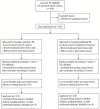Deliberate Play and Preparation Jointly Benefit Motor and Cognitive Development: Mediated and Moderated Effects
- PMID: 27014155
- PMCID: PMC4786558
- DOI: 10.3389/fpsyg.2016.00349
Deliberate Play and Preparation Jointly Benefit Motor and Cognitive Development: Mediated and Moderated Effects
Abstract
In light of the interrelation between motor and cognitive development and the predictive value of the former for the latter, the secular decline observed in motor coordination ability as early as preschool urges identification of interventions that may jointly impact motor and cognitive efficiency. The aim of this study was twofold. It (1) explored the outcomes of enriched physical education (PE), centered on deliberate play and cognitively challenging variability of practice, on motor coordination and cognitive processing; (2) examined whether motor coordination outcomes mediate intervention effects on children's cognition, while controlling for moderation by lifestyle factors as outdoor play habits and weight status. Four hundred and sixty children aged 5-10 years participated in a 6-month group randomized intervention in PE, with or without playful coordinative and cognitive enrichment. The weight status and spontaneous outdoor play habits of children (parental report of outdoor play) were evaluated at baseline. Before and after the intervention, motor developmental level (Movement Assessment Battery for Children) was evaluated in all children, who were then assessed either with a test of working memory (Random Number Generation task), or with a test of attention (from the Cognitive Assessment System). Children assigned to the 'enriched' intervention showed more pronounced improvements in all motor coordination assessments (manual dexterity, ball skills, static/dynamic balance). The beneficial effect on ball skills was amplified by the level of spontaneous outdoor play and weight status. Among indices of executive function and attention, only that of inhibition showed a differential effect of intervention type. Moderated mediation showed that the better outcome of the enriched PE on ball skills mediated the better inhibition outcome, but only when the enrichment intervention was paralleled by a medium-to-high level of outdoor play. Results suggest that specifically tailored physical activity (PA) games provide a unique form of enrichment that impacts children's cognitive development through motor coordination improvement, particularly object control skills, which are linked to children's PA habits later in life. Outdoor play appears to offer the natural ground for the stimulation by designed PA games to take root in children's mind.
Keywords: body weight; children; enrichment; executive function; physical activity; spontaneous play; variability.
Figures





References
-
- Barnett S. M., Ceci S. J. (2002). When and where do we apply what we learn? A taxonomy for far transfer. Psychol. Bull. 128 612–637. - PubMed
LinkOut - more resources
Full Text Sources
Other Literature Sources

